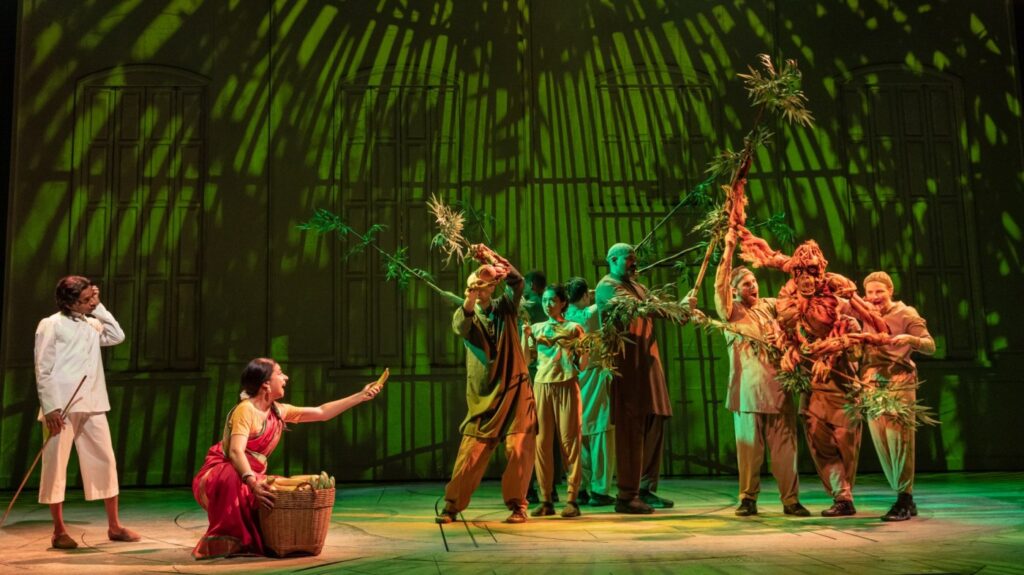
“I’ve had a terrible trip,” says Pi Patel, the lead character in the play “Life of Pi.”
He’s likely the only person at Segerstrom Hall that night who felt that way about it after experiencing his compelling, harrowing journey.
A sensory dazzle, “Life of Pi” is the rare non-musical on the Costa Mesa stage, a wonderfully realized mounting propelled by stage craft at its most magically absorbing.
Derived in part from a 2001 novel, and the 2012 worldwide hit movie, “Life of Pi” charts a 17-year-old’s perilous journey on a Japanese cargo ship with his zookeeping family. They, along with animals in tow, depart from political chaos in India for a new life in Canada.
The craft sinks in a huge storm and Pi is cast into the Pacific Ocean. Good news: he gets on a 20-some-foot lifeboat. Bad news (for him, but terrific for audiences): he’s not alone. And his castaway shipmate has marvelously oversized whiskers, formidable fangs and a ravenous appetite.
As the mesmerizing dive into Pi’s ordeal begins, we learn his name comes from the French word “piscine,” meaning swimming pool. This rapidly makes sense as events literally throw Pi into the deep end.
He narrates his surrealistic tale in flashback form to officials from Japan and Canada who have arrived at an infirmary in Mexico where he has washed ashore. They are investigating what caused the shipwreck and how in the great wide watery world could this castaway survive for 227 days?
First mounted as a play in the UK, “Life of Pi” crossed the Atlantic to capture three technical Tony awards in 2023 on Broadway for Best Lighting Design, Best Scenic Design and Best Sound Design.
Broadway wins are all well and good, but tour productions often leave their pricey tech achievements at home.
Here they are the creative beating heart that — along with an agile, captivating lead performance from actor Taha Mandviwala — transcends the stodgy dialogue in speechifying pronouncements about life’s big questions.
Concentrating on the achievements, let’s start with the puppetry. Most theatergoers of this century are well versed veterans of “The Lion King” school of animal parade pageantry.
Here, Nick Barnes and Finn Caldwell’s zoo menagerie is perhaps even more skillful from a design perspective. The chunk-by-chunk assembly of the oversized animal anatomies is front and center to the audience’s eyes.
This is key when these constructions are manipulated on stage by one to four skillful puppet wranglers: the figurines’ movements breathe lifelike tension into the imagined creatures.
The visual movement exhibited by the animals is key. Kinetic, visual cues translate into instantaneous emotional associations: the gray goat cavorts, so it is lovingly charming; an orange orangutan swings by on its lanky arms and, with a baby, creates affection; hyenas slink and lunge, reaffirming our general concept of their non-stop ruthlessness.
This makes for a delight of first act discoveries. You never know when more simplistic pleasures will arrive, such as schools of fish mounted on a simple stick or a swarm of dancing butterflies.
There is a definite king of beasts in this waterlogged tale. Not a lion, but a fierce Bengal tiger called Richard Parker, accidentally and whimsically misnamed through a paperwork snafu.
Colored in a deep orange-glow with black smear striping, Richard Parker is a cleverly disjointed construction projecting emaciation. This hungry tiger’s menacing, meaningfully paced steps and sudden violent lunges captivate by conveying fury and fascination.
The adversarial relationship — to put it mildly — between Pi and Richard Parker is intense and gripping. Violence and exhaustion, plus control over rare calories coming their way, does not for friendly shipmates make.
And yet, frenemies emerge.
“You’re the only reason I’m alive,” Mandviwala says in an anguished, plaintive tone, manifesting acting rage in a moment of self-discovery which complements his otherwise energized intensity.
“It’s just you and me.”
Director Max Webster hasn’t been content to stop the sensory bliss at animal sightings. The production is a beautiful synchronicity of calibrated technical elements joined together to fully flesh out the storytelling.
A crucial early ingredient is the hyper-naturalistic lighting (co-credited to Tim Lutkin and Tim Deiling). Even before the show moves to the water, vivid pools of rich colors flood quick-moving scenes on land.
These set the show’s visual tone so that later, especially during the lashing storm, visual marvels have become common.
Other technical skills are equally well displayed, somehow drawing our attention yet never feeling self-indulgently showoff-ish.
Related Articles
Choreographer Mark Morris brings the Beatles-inspired ‘Pepperland’ to Beverly Hills
South Coast Repertory announces 2025-26 season
Street Food Cinema returns for 14th season with ‘Wicked,’ a Dolly Parton-themed night and more
Review: ‘Fences’ in Laguna features a suitably fierce leading man
Review: ‘The Staircase’ ascends theatrical heights at South Coast Repertory
The play’s sound (Carolyn Downing) is rich and lustrous throughout, notable showcasing the Indian musical cadences (Andrew T. Mackay is the composer) that propel early scenes.
Scenic and costume design (Tim Hatley) and video animation (Andrzej Goulding) also provide notable parts of the mix.
Overall, “Life of Pi” is an immersive satisfaction that draws one into its tactile world.
And it leads to a guarantee: immersing yourself in this rich theater-making will turn out better than it does for Pi.
He merely survives. We theatergoers, thrive.
‘Life of Pi’
Rating: 3 1/2 stars (out of a possible four)
Where: Segerstrom Hall, Segerstrom Center for the Arts, 600 Town Center Drive, Costa Mesa
When: Through June 15; 7:30 p.m. Tuesdays-Fridays, 2 and 7:30 p.m. Saturdays, 1 and 6:30 p.m. Sundays
Tickets: $44.07-$145.77
Information: 949-556-2787; scfta.org
